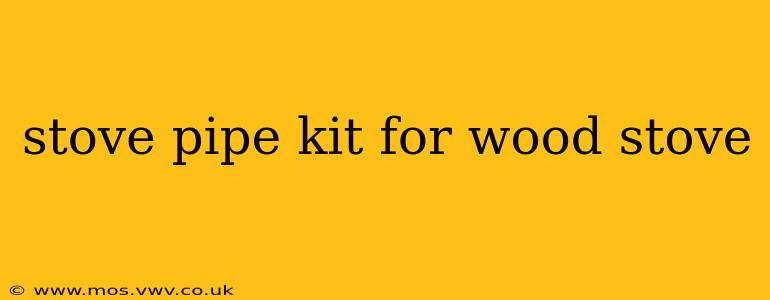Choosing the right stove pipe kit for your wood stove is crucial for safety, efficiency, and longevity. A poorly installed or inadequate chimney system can lead to dangerous situations, including creosote buildup, chimney fires, and carbon monoxide poisoning. This guide will walk you through everything you need to know to select and install the perfect stove pipe kit for your needs.
What is a Stove Pipe Kit?
A stove pipe kit is a pre-packaged set of components designed to connect your wood-burning stove to your chimney. These kits typically include:
- Stove pipe sections: These are the individual lengths of pipe that connect the stove to the chimney. They're usually made of double-walled stainless steel for safety and durability.
- Elbows: These allow you to change the direction of the pipe to navigate obstructions or connect to the chimney at the optimal angle.
- Clamps: These secure the pipe sections together, ensuring a tight and leak-proof connection.
- A ceiling plate (if needed): This protects the ceiling from heat damage if the pipe passes through it.
- A wall plate (if needed): Similar to the ceiling plate, this protects the wall from heat damage.
- A chimney cap: This prevents rain and debris from entering the chimney.
What Size Stove Pipe Kit Do I Need?
Determining the correct size is paramount. The diameter of your stove pipe must match the diameter of your stove's outlet. This information is usually found in your stove's instruction manual. Never attempt to use a pipe that's too small or too large. Using the incorrect size can compromise safety and efficiency.
What Material Should My Stove Pipe Be Made Of?
While some kits use single-wall steel, double-walled stainless steel is highly recommended. Double-walled pipes are designed with an air gap between the inner and outer walls, significantly reducing the external temperature and minimizing the risk of burns or fire hazards. They also offer superior corrosion resistance, extending the lifespan of your chimney system.
How to Install a Stove Pipe Kit: A Step-by-Step Guide (General Overview)
Please Note: This is a general overview. Always refer to your specific stove pipe kit's instructions and consult with a qualified professional if you have any doubts about installation. Improper installation can be extremely dangerous.
- Check Local Codes and Regulations: Before you begin, familiarize yourself with local building codes and regulations regarding wood stove installation.
- Proper Clearance: Ensure sufficient clearance between the stove pipe and combustible materials, as specified by the manufacturer's instructions.
- Assembly: Carefully assemble the pipe sections, elbows, and other components according to the kit's instructions, ensuring tight connections with the clamps.
- Secure Connections: Use appropriate clamps to securely fasten each joint.
- Ceiling/Wall Passages: If necessary, carefully install ceiling or wall plates, ensuring proper sealing to prevent heat leakage and fire hazards.
- Chimney Connection: Connect the stove pipe to your chimney, again ensuring a tight seal.
- Chimney Cap Installation: Install the chimney cap to protect against the elements.
- Inspection: After installation, carefully inspect all connections for leaks or loose parts.
How Often Should I Inspect My Stove Pipe?
Regular inspection is crucial for safety. Inspect your stove pipe at least once a year, preferably before the start of the heating season. Look for cracks, corrosion, rust, or any signs of damage. Check for creosote buildup, which is a highly flammable substance. Excessive creosote buildup is a significant fire hazard.
What are the Signs of a Problematic Stove Pipe?
- Excessive creosote buildup: This indicates insufficient draft or improper burning practices.
- Visible cracks or damage: Any cracks or damage to the pipe compromises its integrity and safety.
- Leaks: Leaks can lead to carbon monoxide poisoning and potential fire hazards.
- Unusual noises: Unusual noises coming from the chimney may indicate issues with the flue or pipe connections.
- Backdrafting: If smoke is entering the room, it indicates a problem with the draft and potentially a blocked or faulty chimney.
Can I Install a Stove Pipe Myself?
While some individuals may feel comfortable undertaking the installation themselves, it's strongly recommended to consult with a qualified professional, especially if you lack experience. Incorrect installation can lead to serious safety hazards. A professional will ensure proper installation, meeting all relevant safety codes and regulations.
What are the Differences Between Single-Wall and Double-Wall Stove Pipes?
As mentioned previously, double-wall stove pipe is safer and more durable than single-wall pipe. The air gap in double-wall pipe significantly reduces the exterior temperature, lowering the risk of burns and fire hazards. Double-wall pipes also offer better resistance to corrosion and have a longer lifespan. Single-wall pipes are generally cheaper, but the increased safety and longevity of double-wall pipes often make them the better long-term investment.
This comprehensive guide should help you choose and install the right stove pipe kit for your wood stove. Remember to always prioritize safety and consult a professional if needed. The safety of your family and home should always be your top priority.
